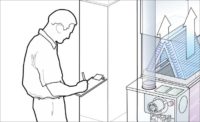Lowe said he keeps the HVAC systems tested and tuned in six engineering and maintenance service centers around Muncie, Ind. These large buildings (up to 150,000 square feet) house all the people and equipment needed to design and maintain electrical transmission facilities: up to 100 line and station mechanics, storeroom technicians, and office personnel.
MONTHLY CHECKS
A trained HVAC technician with 15 years’ experience, Lowe visits his six buildings monthly to monitor and tune their heating and cooling systems. A key step is calculating and adjusting the percent of outside air added to the indoor air supply.Lowe calculates outside air for health, comfort, and code reasons. “Keeping people healthy and comfortable go hand-in-hand,” he said. “Happy workers are productive workers. If you don’t bring outside air in, you’re going to get a buildup of carbon dioxide from the people. It’s a requirement by code that you bring in 10 percent outside air.”
In his previous commercial-industrial HVAC position, local codes were followed very closely. Now, Lowe said he focuses on outside air because it actually makes his job easier. “Fresh air is usually clean air,” he said. “It makes people feel better and keeps the building from being stuffy or stale.”

Warren
Lowe, an HVAC maintenance mechanic for a major Midwest electric utility, uses a
Fluke 975 AirMeter to calculate percent outside air by comparing the percent of
CO2 in return air against the CO2 concentration in outside air.
CO2 CORRECTIONS
People produce CO2 through normal respiration. Although it’s not toxic, its accumulation to excessive levels indoors can indicate that an inadequate amount of outdoor air is being added to the HVAC airflow. High levels of CO2 may also indicate a risk that more toxic air contaminants, such as formaldehyde, may be accumulating.Lowe uses an air meter (the Fluke 975 AirMeter) to calculate the percent of outside air by comparing the percent CO2 in return air against the CO2 concentration in outside air. He also calculates outside air by comparing temperatures of return and outside air.
“What you want is about 300 to 600 parts per million (ppm) of CO2,” Lowe said. “Above that, around 1,000 ppm, people start getting headaches. And above that, they start getting sick.”
Incorporating the right percentage of outside air requires a delicate balancing act. If there’s too little, CO2 builds up. Add too much outside air, especially in the hot, humid Indiana summertime, and a customer may wind up smelling those dirty socks.
What makes it more difficult for Lowe is that he isn’t the only one adding outside air to the mix. His Muncie facility, for instance, includes 35 overhead doors to the outside, each measuring 20 feet tall and 20 feet wide. “We have overhead doors throughout our building,” Lowe said. “You open an overhead door and open a hall door, and you can suck in 10,000 cubic feet of outdoor air in no time. People are opening and closing doors all the time.”
The doors must open for the service center to operate, so Lowe has no choice but to deal with the results: big inflows of humid air drawn into the HVAC ducts, where under the right conditions moisture condenses, providing a medium for bacterial growth that produces the dirty sock smell.
When the odor problem cropped up recently in heat pump ductwork serving the facility, and system adjustments could not cure it, Lowe sanitized the ducts by fogging a chlorine dioxide fungicide and deodorant into the air handler and throughout the supply ducts. The dirty sock odor went away, but the work went on for Lowe, who used his tool for doing duct traverses to measure airflow. He compares his real-time measurements against the design specifications, which he found on the building’s blueprints.
A SHARED METER
The meter has become a shared tool. “We actually ship that meter around to different service centers,” said Lowe. “If an occupant in someone else’s building reports a problem, that maintenance mechanic will let me know. I’ll put it in the ‘pony express,’ ship it to them, and they’ll use it and send it back.”Typically, the other mechanics find CO2 readings above 750 ppm, he said. In some cases, their troubleshooting has uncovered a vehicle parked next to an intake, or a dry sewer trap contaminating the air.
Finally, using a diagnostic tool like this brings with it an important element of credibility. Not infrequently, he said, comfort issues initially blamed on poor IAQ are actually caused by other factors, such as light, noise, or psychology. In these circumstances an air meter can provide data that can help a technician find a solution.
“No one is willing to argue with a tester that is so big and technically sophisticated,” Lowe said. “It solves a lot of trouble. I mean, you bring that meter in there and the people look at it and they think you solved their entire life.”
Publication date:04/18/2011






